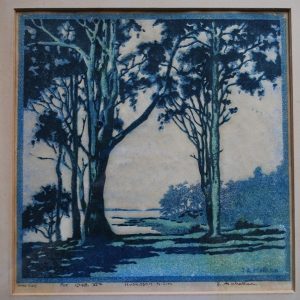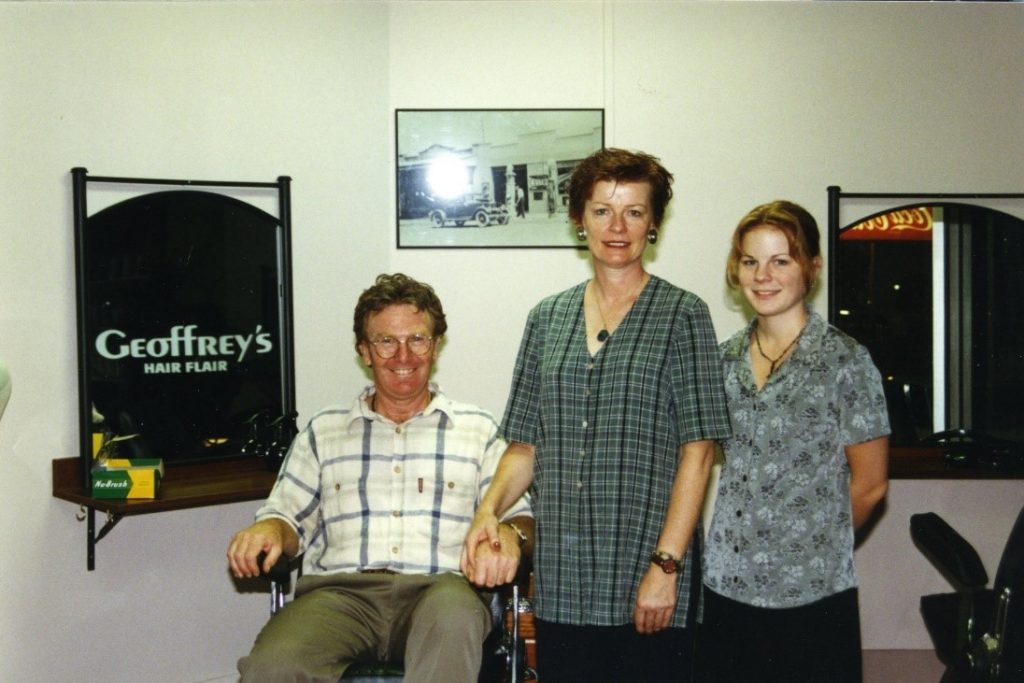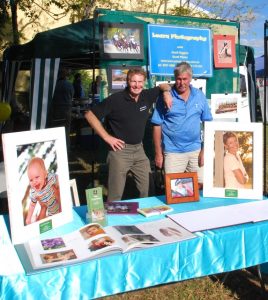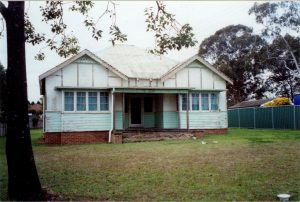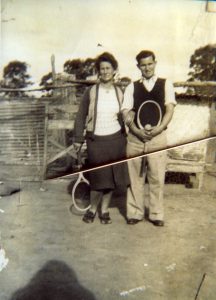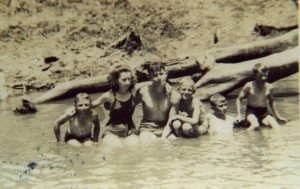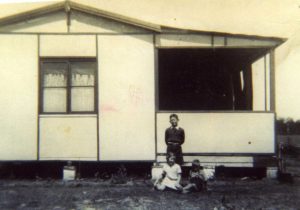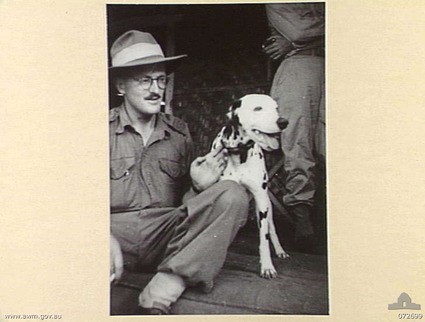by Geoff Pfister
Geoff Pfister wrote the following article of his memories and involvement with the local Rugby League club. Geoff was a gentleman who will be sadly missed.
Growing up and attending school at Schofields was not what you would call the perfect environment for future Rugby League players. Schofields, even to this day, has always been renowned for cricket and soccer but not rugby league. Having said that I still managed to be chosen to represent the Sydney Western Area two years in row whilst attending Schofields Primary School.
In those days I played in the front row because I was always right on the weight limit. It was at high school that I got my first taste at playing full back. I didn’t warm to the position at first because there wasn’t enough action for my liking plus I wasn’t sure exactly what my role as a full back was.
During my high school years I observed that most of the other players were playing on Saturdays for their town teams. At this stage I had never even considered doing that as none of my old Schofield School mates played league. Most of them played cricket which at that time I wasn’t interested in.
So, as a 14 yr old, I took myself down to the footy oval at Riverstone to see if I could make the team. I had no problem making the team as they were desperate for players. After our first trial I realised that it was going to be a long season as we got smashed. There was never any thought that you would even consider playing for another town because loyalty was everything in those days.
Bobby McHugh was my first coach and Eric Martin was the manager. These two guys were very passionate about their football. It didn’t seem to matter how we went their passion never wavered, so much so that one day, just prior to the game starting, their differences of opinion, of which there were many, boiled over resulting in fisticuffs. The players had to intervene by pulling them apart. Very passionate men those two!
Bluey Young was my next coach. Bluey was one of the toughest coaches I ever had, but once again that came from the passion he also had. Bluey thought my best position was lock foreward. I had never played there before but I loved it. As usual, success was always just out of reach. We won a few games but not many. In the age group behind us was a team coached by Charlie Wheeler. They seemed to make the finals every year, at this stage I was starting to think that I was born six months too soon. My birthday was early in the year so I didn’t qualify to play in the team just behind me even though I went to school with some of those players and we were born in the same year.
My other coaches were Ike Schofields, Manny McCarthy, Keith Drayton, and Bluey Senior. When I reached 17yrs I was asked to go up a grade into C Grade or under 19’s they were looking for a full back. It was at this stage that I started to make the position my own. The better I went at it the more I enjoyed playing there. By this time I was one of the smaller players in the team. From that time on I considered myself a full back.
I was fortunate that I was doing an apprenticeship at the time as a barber with Brian McNamara. Brian was a knowledgeable footballer having played first grade with Parramatta in the 50’s so I hung off every bit of advice that he gave me. It was whilst playing C grade that I made my first semi final for Riverstone. We had a pretty good side but unfortunately come semi final time we were struck down by injury. We played the semi with one player, Peter Jayceck taking the field with a broken ankle. We held Parramatta City to nil all at half time. After half time it had become obvious that their coach had realised Peter couldn’t run, so as soon as the second half started, they directed all their play towards his wing. Having said that we still only lost 10 nil, not a bad effort under the circumstances.
The following year was 1967 and Penrith were having trials as they had been included for first time in the First Division of the Sydney Competition, now the NRL competition. I trialled as a fullback and was chosen in the very first Penrith Presidents Cup Side. Presidents Cup was under 19’s and I was one of the youngest in the team having only just turned 18. Two other players from Riverstone also made that side, Michael Britton and David “Birdie” Simpson.
My first coach at Penrith was one of Riverstone’s own, Charlie Sandilands. Charlie played most of his career as a full back so it was very fortunate for me as he had heaps of valuable tips for me. We played four games winning two and losing two so that was that for us. At the end of our commitment to President Cup, Penrith organised a mid week trial against their 3rd grade. They beat us 3 nil but the selectors saw plenty of potential coming from this relatively young side and chose nine members of our President Cup to play third grade the next Saturday against Parramatta at Cumberland Oval.
I was fortunate to be one of those chosen, but for some reason they played me in the centres which I wasn’t comfortable with but I was still very happy to have been picked. Just a few minutes into that game the Eels moved the ball quickly to their left winger who took off like a scalded cat down the touch line to score in the corner without a hand being laid on him. I said to my centre partner “who was that” and he replied “oh that’s Dave Irvine” who at the time was Australian beach sprint champion and of course cousin of the famous Ken Irvine.
That first game for Penrith was one of the scariest yet most memorable times in my footy career, I will always treasure the fact that I was the first player from Riverstone to play grade with Penrith. Even though it was only third grade for me it was a big deal. Many far more talented players have since played at a much higher level, Joel Clinton in particular having played for Australia. The other things that stand out for me during this time was training with first grade, playing at all the famous suburban grounds and scoring a try at the Sydney Sports Ground which was Eastern Suburbs home ground at that time. I ended up playing the rest of the season in third grade, eleven games in all.
The following season didn’t start well for me, getting a knee injury in a trial against Manly, would you believe at Riverstone Oval of all places? The injury never cleared itself that year and as a result I was unable to complete a single game that season.
The following year I decided that I wasn’t going to make it in the big time so I returned to play at Riverstone. I was chosen as fullback in the A grade that year, 1969. We had a very young side made up mostly of the players who were in the grade just under me all the way through the juniors. The coach was Charlie Wheeler and Robby “Knuckles” Shepherd the manager. This team was full of goers and there was great spirit and self-belief among this bunch.
We had a very successful year winning more games than we lost which was rare for most of the teams I played in. We made the semi finals that year with the promise of better things ahead. The following year a couple of new additions to the side made all the difference. Alan Watton and Harry Mitton joined the team; both were front rowers with a bit of size about them, just what we needed. Alan was the captain of the side and as well as being a great player he was a great leader, Charlie Wheeler once again coached the side and as usual he had 100% support of the players. Charlie really cared about his players and in return we would do anything he asked of us.
A member of Charlie’s support staff was Gordon West, who used to treat the injured players on Tuesday evenings. Gordon had huge hands and big strong arms which he used to full effect when massaging the players. Gordon wasn’t happy unless he had you screaming for mercy and as a result we tried to spend as little time as possible being treated by Gordon. Looking back now I think this was a deliberate ploy by Charlie to get us back on the training paddock. That year we finished the season as minor premiers but unfortunately we were beaten by Richmond in the grand final 12 to 8.
That was 1970 the year I retired because by this time I had purchased the barber shop from Brian McNamara and the next year I was getting married so I couldn’t afford to get injured. That year I was chosen as the best and fairest in A grade, receiving the trophy from Barry Rushworth at our annual presentation night. When I retired I was 22 years of age and I thought that my involvement with football and Riverstone Football Club was over forever.
That was until my son Ryan, started to play in the under 7’s in early 80’s. Unfortunately I could not attend many games as I worked Saturdays and it was the busiest day of the week. I managed to squeeze in a few games throughout the season. Ryan played again the next year but to my surprise he announced at the end of the season that he was retiring from football after only two seasons.
For the next eight years Ryan showed very little interest in football at all until he reached 16yrs of age. The under 16’s played on Sundays which meant that I and my wife Rosalin, could both attend. Rosalin used to drop him off at training and I would go down after work and watch the team train then bring him home. I could not imagine what was about to unfold before me. After only four games into the season the Club was considering sacking the coach and his manager but first they had to find a new coach. I had not even considered coaching before when they approached me, but now I realised that I was already there most of the time anyway. So I accepted the offer and my return to the Riverstone Football Club was complete.
Big Al (Alan Owen) was my manager that year and I could not have asked for a better person to have by my side. I will always remember the night I took over officially as coach. Alan said come on Geoff and I will introduce you to the boys. The first thing he said to the boys was “even though Geoff is a hairdresser he’s alright!” I think this was meant to reassure them that I wasn’t going to try and kiss them or anything like that.
This team of footballers had a reputation for being the most difficult and worst behaved in the club but with talent to burn. My short experience watching them was that most of the time that’s what they did, they burned. The biggest problem was that no one had shown them any respect so they didn’t show any in return. My main concentration was skill training and they loved it. The more I showed them the better they responded. We made the semi finals that year which was quite an effort considering where we had come from.
Two big things happened the next season, things that would forever influence the way I coached and ran the side. My good mate Bruce Rutledge became my assistant coach and Michael Carter became the team manager. This was a powerful mix and what I consider the perfect union. Bruce has a very astute football brain and Michael is probably the best administrator book keeper I have ever known. It didn’t seem to matter what statistic I needed, or phone number, Michael had it for me. I was the person out the front with the gift of the gab but with a wonderful team in support. We never had a single argument amongst ourselves but like all good teams plenty of good healthy debate.
Little did we realise at the start of the 1993 season what a unique year it was to become. The start to the 1993 season could not have gone any worse with players not willing to commit to playing as well as some very unwelcome additions to the side. After our first trial at Riverstone I stormed onto the field and ripped the jumper of one of the players. I was that disgusted at the way he had conducted himself and the total disrespect he showed for that jumper. He was never sighted at Riverstone again.
On top of that we also had some very welcome new blood that would turn out to be just what was needed. We lost our first game of the season in what can only be described as a diabolical performance. After that game I made some major positional changes that turned out better than I could ever have imagined. We never lost another game all season going on to defeat West Mt Druitt in the grand final at Penrith Stadium.
The next season I coached the under 19’s who were playing first division which is regarded as one of the toughest in all of Sydney but we had a very talented group of players on our roster. Behind the scenes the “A” team of Bruce and Michael were still on board. We had another very successful year but unfortunately we were knocked out in the first semi final by Blacktown. Injury to key members of the team unfortunately brought us undone. In the last game of the season that year we defeated St Mary’s who went on to win the grand final so we were more than capable of going all the way and we believed as a team we could have won it.
The next season I was appointed coach of the A Grade. This was a whole new ball game for myself, Bruce and Michael. Expectations are always high for the town’s A grade so if you don’t win your fair share of games the critics come out of the woodwork from all directions. Being appointed A grade coach is something that I will always regard as a great honour and privilege. We had assembled an outstanding team in the off season and the vibe around the club was very positive going into the 1995 season. The first couple of trials went very well so expectations were high but unfortunately serious injuries started to come one after the other.
By the time the season started we had lost all our forward pack except for one player, Steven Welfare plus half our backline was out for the season. So we started the season with virtually a reserve grade side in one of the toughest junior league competitions anywhere. We never won a game that year but my hat goes off to those players who hung in there week after week. I have more admiration for their courage than you could ever imagine. They bled for Bruce and me that year and I will always regard them as a very special group of young men with enormous courage.
The next year we were relegated to second division. We had a good player roster to work with and made the final that year narrowly going down to Katoomba who went on to win the competition.
I decided to call it quits at the conclusion of the 1996 season. My wife had become a football widow and it was time I spent more time with her for a change plus I had had five of the most memorable years of my life. I would like to take this opportunity to thank the committee for their support, particularly Ian Lawrence, Col Russell, Biddy Stone, Mark Stacey, Graham Delarue and of course Big Al. From the coaching side of things Snowy Barlow, Grant Bergman, Paul Melanick, Stumpy Cartwright, Peter Wynans and of course my team manager in 1996, Glen Hunter, were always there for me. These guys were then, and still today, what the heart and soul of Riverstone Football club is all about and I thank them for their support and friendship.
